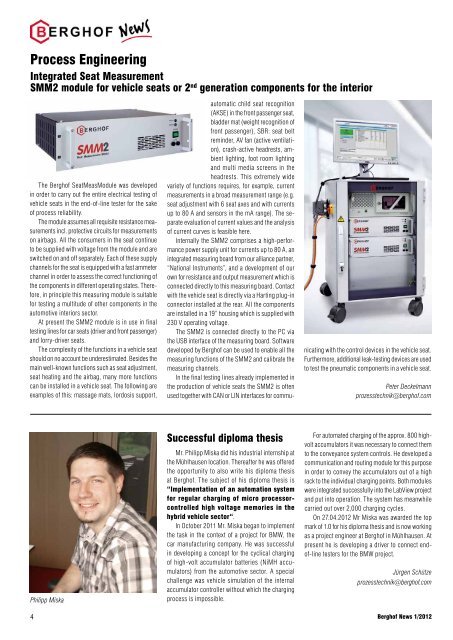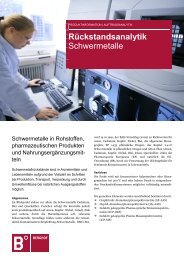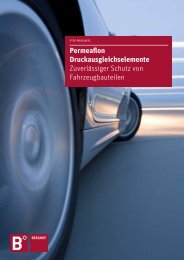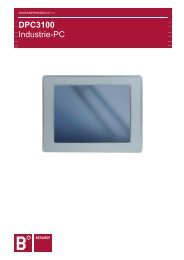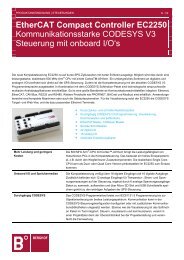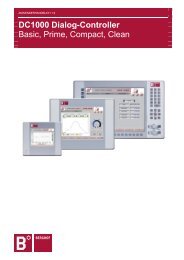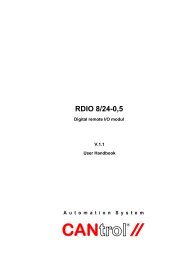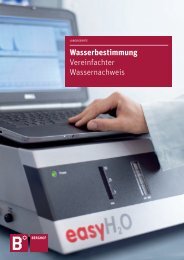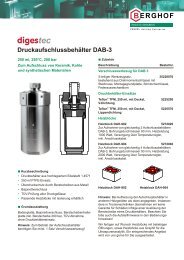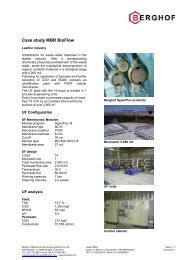Controls - Berghof
Controls - Berghof
Controls - Berghof
You also want an ePaper? Increase the reach of your titles
YUMPU automatically turns print PDFs into web optimized ePapers that Google loves.
Process Engineering<br />
Integrated Seat Measurement<br />
SMM2 module for vehicle seats or 2 nd generation components for the interior<br />
The <strong>Berghof</strong> SeatMeasModule was developed<br />
in order to carry out the entire electrical testing of<br />
vehicle seats in the end-of-line tester for the sake<br />
of process reliability.<br />
The module assumes all requisite resistance measurements<br />
incl. protective circuits for measurements<br />
on airbags. All the consumers in the seat continue<br />
to be supplied with voltage from the module and are<br />
switched on and off separately. Each of these supply<br />
channels for the seat is equipped with a fast ammeter<br />
channel in order to assess the correct functioning of<br />
the components in different operating states. Therefore,<br />
in principle this measuring module is suitable<br />
for testing a multitude of other components in the<br />
automotive interiors sector.<br />
At present the SMM2 module is in use in final<br />
testing lines for car seats (driver and front passenger)<br />
and lorry-driver seats.<br />
The complexity of the functions in a vehicle seat<br />
should on no account be underestimated. Besides the<br />
main well-known functions such as seat adjustment,<br />
seat heating and the airbag, many more functions<br />
can be installed in a vehicle seat. The following are<br />
examples of this: massage mats, lordosis support,<br />
Philipp Miska<br />
automatic child seat recognition<br />
(AKSE) in the front passenger seat,<br />
bladder mat (weight recognition of<br />
front passenger), SBR: seat belt<br />
reminder, AV fan (active ventilation),<br />
crash-active headrests, ambient<br />
lighting, foot room lighting<br />
and multi media screens in the<br />
headrests. This extremely wide<br />
variety of functions requires, for example, current<br />
measurements in a broad measurement range (e.g.<br />
seat adjustment with 6 seat axes and with currents<br />
up to 80 A and sensors in the mA range). The separate<br />
evaluation of current values and the analysis<br />
of current curves is feasible here.<br />
Internally the SMM2 comprises a high-performance<br />
power supply unit for currents up to 80 A, an<br />
integrated measuring board from our alliance partner,<br />
“National Instruments”, and a development of our<br />
own for resistance and output measurement which is<br />
connected directly to this measuring board. Contact<br />
with the vehicle seat is directly via a Harting plug-in<br />
connector installed at the rear. All the components<br />
are installed in a 19” housing which is supplied with<br />
230 V operating voltage.<br />
The SMM2 is connected directly to the PC via<br />
the USB interface of the measuring board. Software<br />
developed by <strong>Berghof</strong> can be used to enable all the<br />
measuring functions of the SMM2 and calibrate the<br />
measuring channels.<br />
In the final testing lines already implemented in<br />
the production of vehicle seats the SMM2 is often<br />
used together with CAN or LIN interfaces for commu-<br />
Successful diploma thesis<br />
Mr. Philipp Miska did his industrial internship at<br />
the Mühlhausen location. Thereafter he was offered<br />
the opportunity to also write his diploma thesis<br />
at <strong>Berghof</strong>. The subject of his diploma thesis is<br />
“Implementation of an automation system<br />
for regular charging of micro processorcontrolled<br />
high voltage memories in the<br />
hybrid vehicle sector“.<br />
In October 2011 Mr. Miska began to implement<br />
the task in the context of a project for BMW, the<br />
car manufacturing company. He was successful<br />
in developing a concept for the cyclical charging<br />
of high-volt accumulator batteries (NiMH accumulators)<br />
from the automotive sector. A special<br />
challenge was vehicle simulation of the internal<br />
accumulator controller without which the charging<br />
process is impossible.<br />
nicating with the control devices in the vehicle seat.<br />
Furthermore, additional leak-testing devices are used<br />
to test the pneumatic components in a vehicle seat.<br />
Peter Deckelmann<br />
prozesstechnik@berghof.com<br />
For automated charging of the approx. 800 highvolt<br />
accumulators it was necessary to connect them<br />
to the conveyance system controls. He developed a<br />
communication and routing module for this purpose<br />
in order to convey the accumulators out of a high<br />
rack to the individual charging points. Both modules<br />
were integrated successfully into the LabView project<br />
and put into operation. The system has meanwhile<br />
carried out over 2,000 charging cycles.<br />
On 27.04.2012 Mr Miska was awarded the top<br />
mark of 1.0 for his diploma thesis and is now working<br />
as a project engineer at <strong>Berghof</strong> in Mühlhausen. At<br />
present he is developing a driver to connect endof-line<br />
testers for the BMW project.<br />
Jürgen Schütze<br />
prozesstechnik@berghof.com<br />
4 <strong>Berghof</strong> News 1/2012


